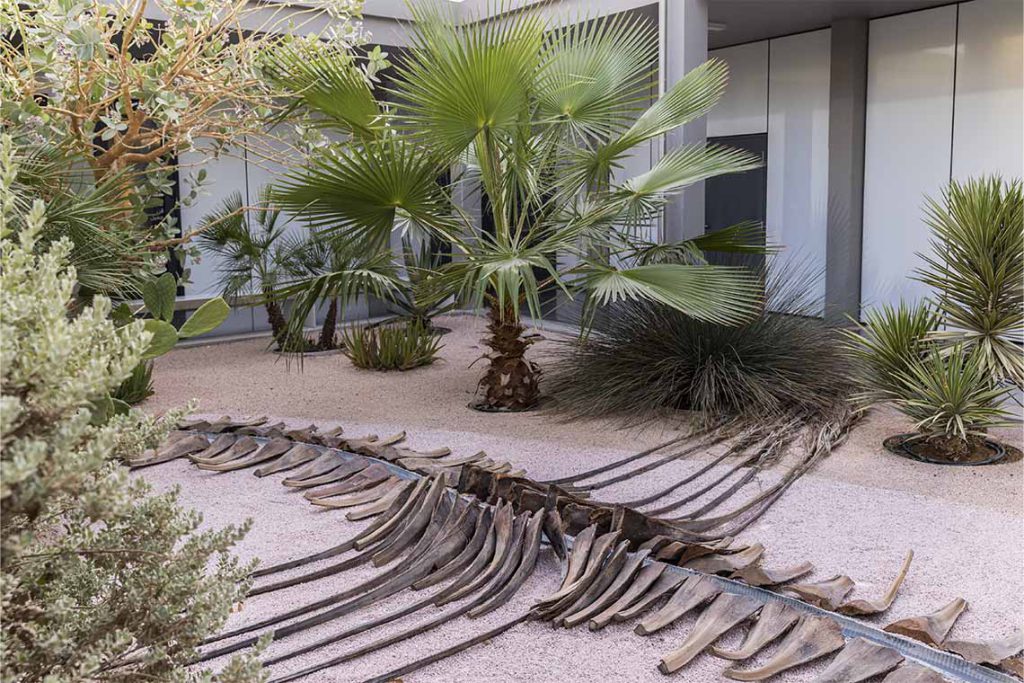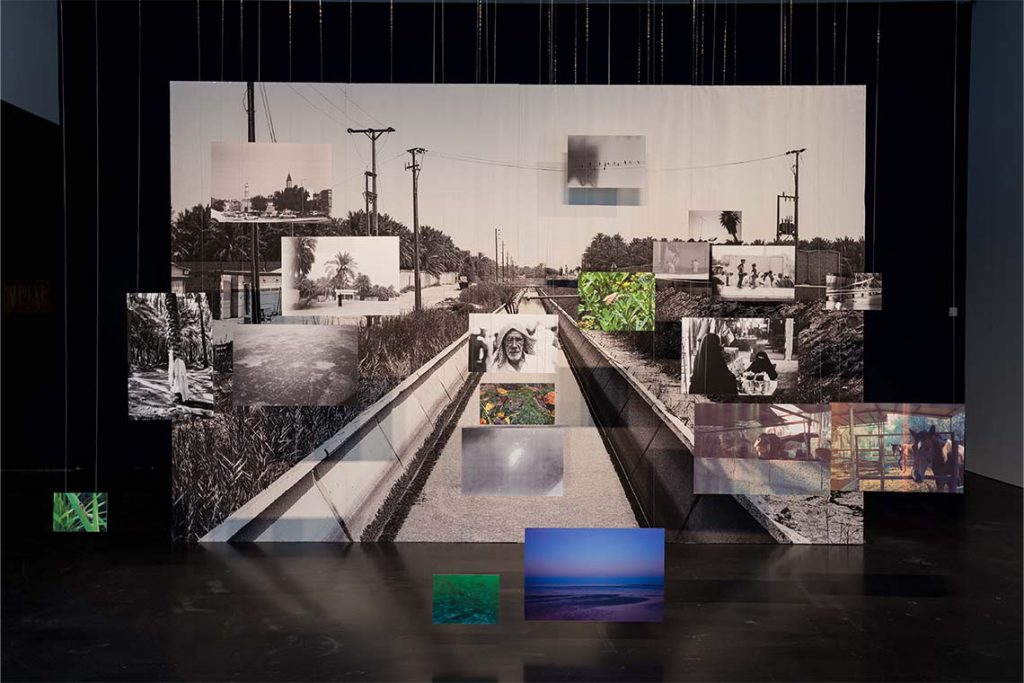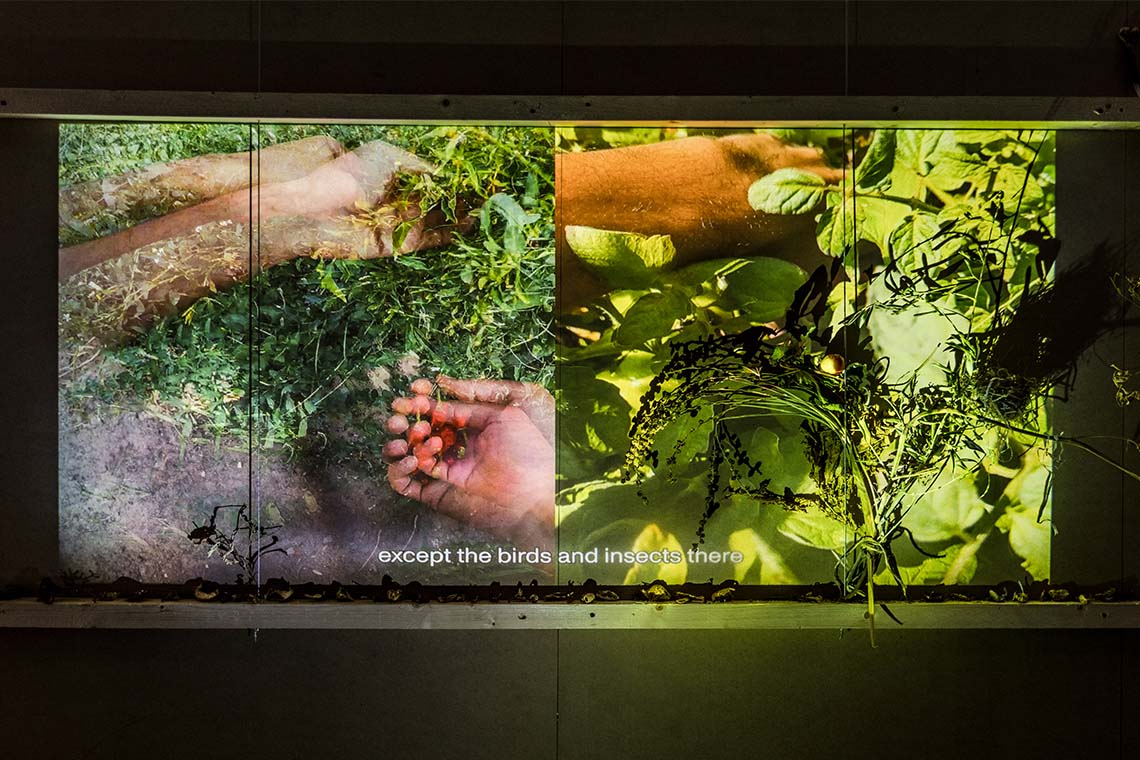In his first institutional solo show, Mohammad Alfaraj at Jameel Arts Centre weaves a constellation of recurring symbols and multi-species narratives, both fiction and reality.
Drawing from his upbringing in Al-Ahsa, Mohammad Alfaraj’s spiritual and allegorical practice moves fluidly across media to bridge the symbolic with the material. The Saudi artist’s inaugural solo exhibition at Dubai’s Jameel Arts Centre, Seas are sweet, fish tears are salty, takes its title from a poem he wrote that carries a charming naivety and empathy mirroring how he senses the world and its ecosystems. This self-described childlike logic and curiosity persist throughout the exhibition, despite its institutional context. Rotana Shaker’s curatorial framing weaves works across the galleries before winding them beneath staircases and spilling them into the courtyards.
Outside the entrance, Fossils of Knowledge (2019–25) rests in a patch of gravel and soil surrounded by a small oasis of plants. The skeletal form, shaped from palm bark, resembles the remains of a mysterious creature, alluding to the fragility and memory of the land and warning that any intimately lived cultural and agricultural wisdom it holds could soon become extinct. In this fossilisation, Alfaraj also speculates that the ancestral knowledge might one day be unearthed and revered anew.
This idea of regeneration and truth runs through much of Alfaraj’s work as he reflects on how objects shift in meaning, and how something as familiar and integral as a palm tree can be reimagined into a new truth, perceiving tree stumps as bones and withered fronds as a bird’s wings. He refers to such found materials as “memory capsules”, already embedded with their own ecological and emotional histories. As such, his sculptures become humble assemblages of stories embodying the oral traditions, natural landscapes and rituals of the oasis of Al-Ahsa.

The darkness of Gallery 3 reflects this spirit of imagination and intuition most fully as it assembles a constellation of sculptural encounters. Anchoring this room is Love is to leave the door to your garden ajar (2025), a gathering nook and intimate enclosure of thresholds. Although its structure, assembled from salvaged doors, suggests shelter, its many openings resist containment and encapsulate the convivial generosity of the informal farm structures from which it draws. Surrounding it, two films responding to the landscape and social fabric of Al-Ahsa are laid out almost precariously on the ground – one projected onto a bed of sand, the other onto ripples of water. In sand, The Date Fruit of Knowledge (2022) tells the story of a bird that tries to gather all knowledge at once, only to realise it must be acquired slowly over time. Nearby, the sculpture Poetry Is A Bird Trying To Escape The Cage of Language (2025) depicts the wings of a bird desperate to break out from confinement, reflecting the spirit’s desire for freedom and the constraints that bind it.
Don’t Touch My Tomato (2025) expands this exploration of multi-species storytelling, using the perspectives of human and non-human entities. This framing shifts attention to each narrator’s perceived reality of claiming or losing access to the same land, without resolving any of their grievances; a farmer sees a tomato as his reward for labour, while a bird sees it as sustenance within its native landscape. The tomato, nurtured and devoured by both, is given a voice of its own in the film.
There is a recurring attention here to truth as a product of reality and imagination, truth that may sit outside of fact, and an acceptance to hold truth in all its plurality so long as it exists in belief. Fossils of Time (2022) plays with this ambiguity through spatial illusions depicting layers of ecologies. The installation at first glance appears to be a single monochrome landscape, overlaid with images of Al-Ahsa’s flora, fauna and inhabitants. Moving through the gallery disrupts the illusion of flatness as these images reveal themselves as suspended, fragmented collages. These works occupy Gallery 2 where the curatorial language shifts towards more conventional structures and articulates narratives closer to lived realities. Yet Alfaraj’s characteristic sensibilities seep through as reflective notes, etchings on the wall and a glimpse of an outdoor installation of suspended food cans. A Phone Call to the Heavens (2025) strings together these discarded cans, which sway in the wind and catch sound to form a connection with the divine. “It’s really just a prayer, like you’re making a phone call to heaven,” the artist explains. “Asking the sky for more good in the world.”

Radio AlKhayal (2025) draws this sense of longing inward towards the act of human communication as a non-visual experience. The phone booth made from cardboard fruit crates features headphones fashioned from cans, playing an audio piece that drifts into a reflection on tensions between existence and fiction. Both installations revisit and reimagine the playful childhood memory of using cans as makeshift telephones, reimagining them as instruments.
Throughout, Alfaraj retains patience and tenderness in his approach to storytelling and multimedia methods of archiving to protect what is at risk of vanishing. The exhibition’s recurring characters – birds, fruits, fossils and the earth itself – each carry the weight of perspectives that might recover truths we may soon be mourning. Through them, he brings the knowledge systems, ecosystems and traditions of his hometown to life while weaving through parables that position storytelling as a lived practice allowing for new ways of seeing, remembering and imagining our futures.
Seas are sweet, fish tears are salty runs until 4 January 2026



